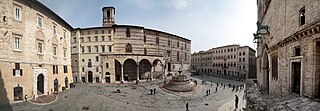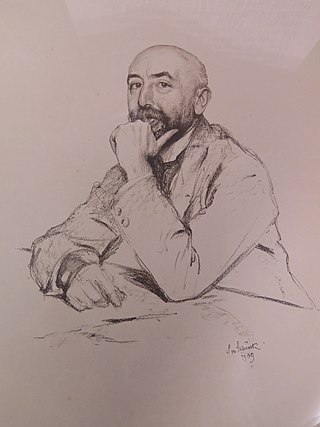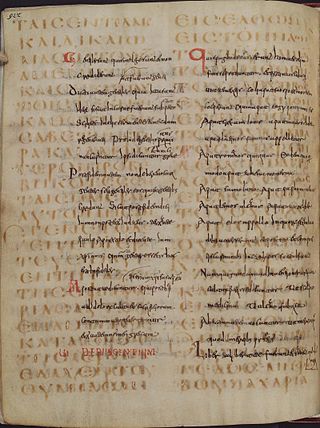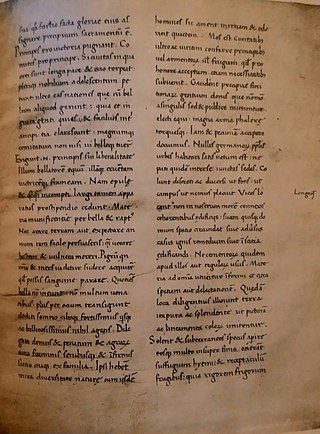Related Research Articles

Year 549 (DXLIX) was a common year starting on Friday of the Julian calendar. The denomination 549 for this year has been used since the early medieval period, when the Anno Domini calendar era became the prevalent method in Europe for naming years.

Perugia is the capital city of Umbria in central Italy, crossed by the River Tiber, and of the province of Perugia. The city is located about 164 km (102 mi) north of Rome and 148 km (92 mi) southeast of Florence. It covers a high hilltop and part of the valleys around the area. The region of Umbria is bordered by Tuscany, Lazio, and Marche.

Baldus de Ubaldis was an Italian jurist, and a leading figure in Medieval Roman Law and the school of Postglossators.

The Codex Argenteus is a 6th-century illuminated manuscript, originally containing part of the 4th-century translation of the Christian Bible into the Gothic language. Traditionally ascribed to the Arian bishop Wulfila, it is now established that the Gothic translation was performed by several scholars, possibly under Wulfila's supervision. Of the original 336 folios, 188—including the Speyer fragment discovered in 1970—have been preserved, containing the translation of the greater part of the four canonical gospels. A part of it is on permanent display at the Carolina Rediviva building in Uppsala, Sweden, under the name "Silverbibeln".

Robert Michels was a German-born Italian sociologist who contributed to elite theory by describing the political behavior of intellectual elites.

Aurvandill is a figure in Germanic mythology. In Norse mythology, the god Thor tosses Aurvandill's toe – which had frozen while the thunder god was carrying him in a basket across the Élivágar rivers – into the sky to form a star called Aurvandils-tá. In wider medieval Germanic-speaking cultures, he was known as Ēarendel in Old English, Aurendil in Old High German, Auriwandalo in Lombardic, and possibly as auzandil in Gothic. An Old Danish Latinized version, Horwendillus (Ørvendil), is also the name given to the father of Amlethus (Amleth) in Saxo Grammaticus' Gesta Danorum. Comparative studies of the various myths where the figure is involved have led scholars to reconstruct a Common Germanic mythical figure named *Auza-wandilaz, which seems to have personified the 'rising light' of the morning, possibly the Morning Star (Venus). However, the German and – to a lesser extent – the Old Danish evidence remain difficult to interpret in this model.

The Gothic alphabet is an alphabet used for writing the Gothic language. Ulfilas developed it in the 4th century AD for the purpose of translating the Bible.

University of Perugia is a public-owned university based in Perugia, Italy. It was founded in 1308, as attested by the Bull issued by Pope Clement V certifying the birth of the Studium Generale.
Ernesto Gastaldi is an Italian screenwriter. Film historian and critic Tim Lucas described Gastaldi as the first Italian screenwriter to specialize in horror and thriller films. Gastaldi worked within several popular genres including pepla, Western and spy films.

Adolph Goldschmidt was a Jewish German art historian. He taught at University of Berlin from 1892 to 1903, and University of Halle from 1904 to 1912.

The Gothic Bible or Wulfila Bible is the Christian Bible in the Gothic language spoken by the Eastern Germanic (Gothic) tribes in the early Middle Ages.

Codex Guelferbytanus A designated by Pe or 024, ε 33, is a Greek uncial manuscript of the Gospels, dated palaeographically to the 6th century. The manuscript is very lacunose.

Gothic is an extinct East Germanic language that was spoken by the Goths. It is known primarily from the Codex Argenteus, a 6th-century copy of a 4th-century Bible translation, and is the only East Germanic language with a sizeable text corpus. All others, including Burgundian and Vandalic, are known, if at all, only from proper names that survived in historical accounts, and from loanwords in other languages such as Portuguese, Spanish, and French.

Codex Carolinus is an uncial manuscript of the New Testament on parchment, dated to the 6th or 7th century. It is a palimpsest containing a Latin text written over a Gothic one. The Gothic text is designated by siglum Car, the Latin text is designated by siglum gue or by 79, it represents the Old Latin translation of the New Testament. It is housed in the Herzog August Library in Wolfenbüttel in Lower Saxony, Germany.
Franz Anton Knittel was a German, Lutheran orthodox theologian, priest, and palaeographer. He examined palimpsests' text of the Codex Guelferbytanus 64 Weissenburgensis and deciphered text of Codex Carolinus. He was the author of many works.

Lombardic or Langobardic is an extinct West Germanic language that was spoken by the Lombards, the Germanic people who settled in Italy in the sixth century. It was already declining by the seventh century because the invaders quickly adopted the Latin vernacular spoken by the local population. Lombardic may have been in use in scattered areas until as late as c. 1000 AD. Many toponyms in modern Lombardy and Greater Lombardy and items of Lombard and broader Gallo-Italic vocabulary derive from Lombardic.

Stefania Giannini is an Italian politician and linguist. She served as Minister of Education, Universities and Research from 2014 until 2016. She is currently Assistant-Director General for Education at UNESCO in Paris.
Lutz E. von Padberg is a German historian whose specialty is medieval history and in particular the Christianization of the Germanic peoples. He is an expert on Saint Boniface, having written biographies of the saint and studies of his veneration.

The Codex Aesinas is a 15th-century composite manuscript. It was discovered by chance in 1902 at the former private estate of the Count Baldeschi Balleani family located in Jesi, in the province of Ancona, Italy. The manuscript is considered especially valuable because it contains the Opera Minora of the Roman historian Tacitus, including the Agricola and the Germania. Due to the inclusion of eight folia written in Carolingian minuscule script within the Agricola, the Tacitus portion of the Codex is generally regarded as a direct copy of the missing Codex Hersfeldensis (H), a 9th-century manuscript that contained a copy of the original Opera Minora by Tacitus. The Carolingian folia are thought to be originals taken from the lost codex. In 1994, the Baldeschi Balleani family sold the codex to the Biblioteca Nazionale Centrale di Roma where it is now known as the Codex Vittorio Emanuele 1631.
References
- ↑ "Carla Falluomini - Università degli Studi di Perugia". www.unipg.it. Retrieved 2020-12-22.
- 1 2 3 "Carla Falluomini". festival.bergamoscienza.it (in Italian). Retrieved 2020-12-22.
- ↑ Knittel, Ulphilae versionem Gothicam nonnullorum capitum epistolae Pauli ad Romanos e litura MS. rescript Bibliothecae Guelferbytanae, cum variis monumentis ineditis eruit, commentatus est, detitque foras, Brunovici 1762